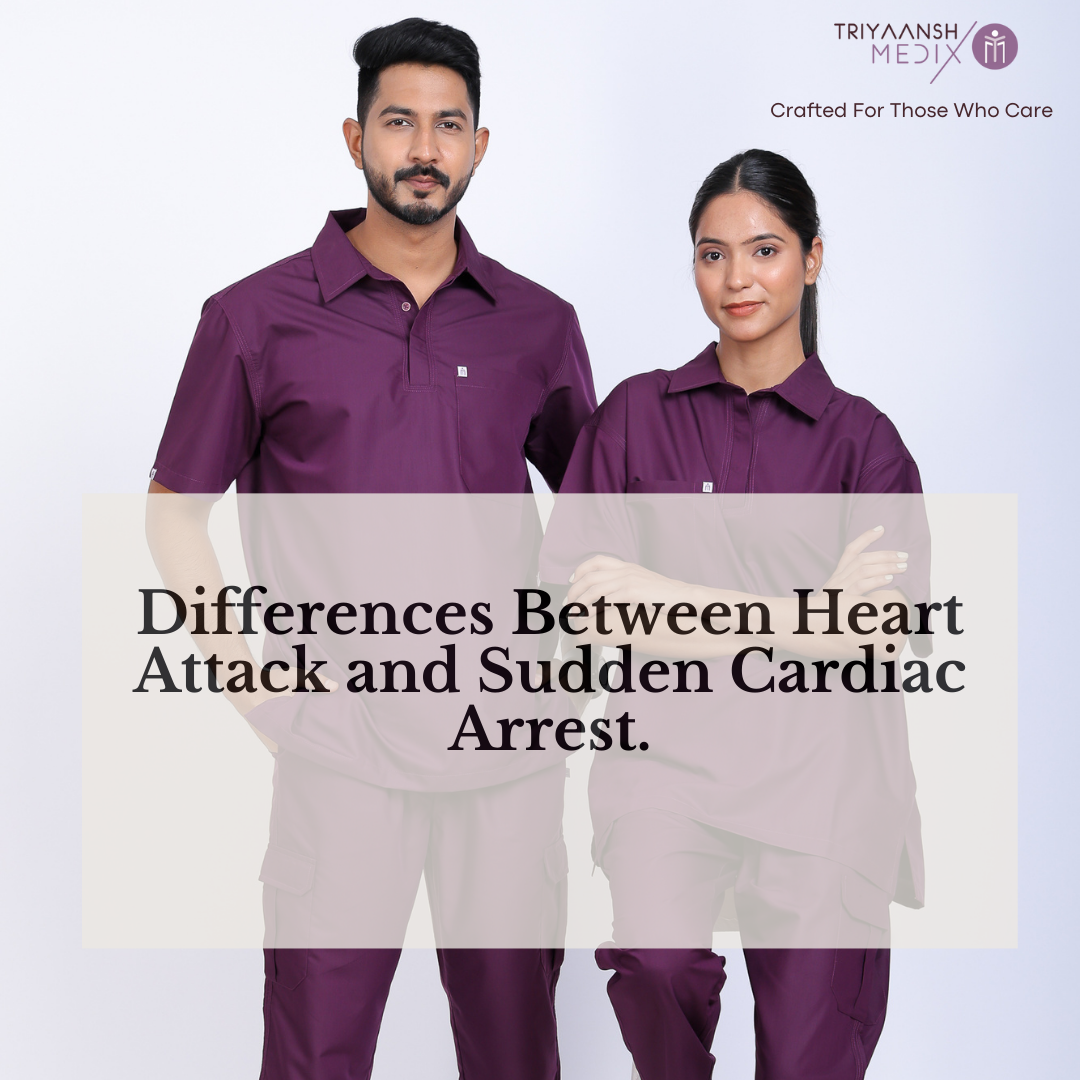People frequently use these terms interchangeably, but they are not synonymous. A heart attack occurs when blood flow to the heart is blocked. Sudden cardiac arrest occurs when the heart malfunctions and abruptly stops beating. A heart attack is a "circulation" problem, whereas sudden cardiac arrest is a "electrical" problem.
What constitutes a heart attack?
A heart attack occurs when an artery is blocked, preventing oxygen-rich blood from reaching a section of the heart. If the blocked artery is not quickly reopened, the part of the heart that is normally supplied by it begins to die. The longer a person goes without treatment, the more severe the damage.
The diagnosis of heart attack
A heart attack is also known as a myocardial infarction, or simply "MI." A heart attack occurs when a blockage in one or more coronary arteries reduces or stops blood flow to the heart, depriving some of the heart muscle of oxygen.
The blood vessel blockage may be complete or partial.
A complete blockage of a coronary artery is known as an ST-elevation myocardial infarction (STEMI).
A partial blockage results in a non-ST-elevation myocardial infarction (NSTEMI).

Diagnostic tests and procedures assist your medical team in determining whether you had a heart attack, how much damage your heart sustained, and the severity of your coronary artery disease (CAD). The tests assist the health care team in determining the appropriate treatment and lifestyle changes to improve your heart health and prevent future medical events.
A needle stick may be used in non-invasive diagnostic imaging tests, such as an intravenous injection of a contrast agent. Invasive procedures may include the insertion of a tube, device, or scope, as well as blood tests.
Blood tests may include cardiac enzymes (e.g. troponin, creatine kinase), CRP, fibrinogen, homocysteine, lipoproteins, triglycerides, BNP, and prothrombin.
Reason for the Test
Confirms that a heart attack has occurred and assesses the extent of the damage.
Assess your future risk for coronary artery disease.
Provides information on how long it takes for the blood to clot.
If you've had a heart attack, you may have already gone through some procedures to help you survive. Those same procedures can aid in diagnosing your condition. These procedures include:
Thrombolysis: Many STEMI heart attack patients will require thrombolysis, which is a procedure that involves injecting a clot-dissolving agent into a coronary artery to restore blood flow. This procedure is performed within a few hours (typically three) of a STEMI heart attack.
Coronary angioplasty/coronary artery bypass graft surgery (CABG): If thrombolysis treatment is not started right away after a heart attack, many people will require coronary angioplasty and stenting or CABG to improve blood supply to the heart muscle.
Common forms and therapies for heart attacks
Your medical team will recommend treatments based on the type of heart attack (also known as myocardial infarction, or MI) you had. A heart attack occurs when a blockage in one or more of the heart's (coronary) arteries reduces or stops blood flow to the heart, depriving part of the muscle of oxygen.
The blockage may be complete or partial.
A complete blockage of a coronary artery indicates that you experienced a "STEMI" heart attack, or ST-elevation MI.
A partial blockage is referred to as a "NSTEMI" heart attack, or a non-ST-elevation MI.
STEMI and NSTEMI heart attacks require different treatments, though there may be some overlap.
Hospitals employ these methods to get blood flowing again to the area of your heart muscle that was injured during your heart attack:
You may be treated with surgery, a balloon angioplasty, clot-dissolving medications (thrombolysis), or a mix of these.
Commonly performed medical treatments after a heart attack:
This is a list of numerous standard medical procedures for heart attacks. For in-depth descriptions of these therapies, visit our page dedicated to heart surgery.
During an angioplasty, specialized tubing is inserted into the coronary arteries along with a deflated balloon. The balloon is inflated to open up restricted areas where the heart muscle's blood supply has been diminished or stopped.
Laser angioplasty: This procedure is comparable to angioplasty, but the catheter's laser tip opens the clogged artery.

Heart valve surgery involves either the replacement of a healthy heart valve or the repair of an abnormal or diseased one.
Atherectomy: This procedure is comparable to angioplasty, but the catheter's tip contains a unique instrument for removing plaque from the artery.
Bypass surgery: This procedure opens up new channels around the clot to allow blood to reach the heart muscle, treating blocked heart arteries.
Small incisions are used in minimally invasive cardiac surgery as an alternative to traditional bypass surgery.
Procedure for a stent: During an angioplasty, a wire-mesh tube called a stent is inserted to keep an artery open and restore blood flow.
Transmyocardial revascularization (TMR): The heart's pumping chamber is perforated with a series of holes drilled from the exterior using a laser.
Medical Management :
Many medications are used in the treatment of heart attacks. An overview of the common types is given in the list that follows. More information about cardiac medications is also available.
The optimal prescription regimen for you will be suggested by your medical team.
Anticoagulant: Also known as blood thinners, these medications prevent blood clots from growing larger and make it more difficult for new clots to form.
Antiplatelet agent: Prevents blood platelets from adhering to one another, hence preventing blood clots from forming.
Angiotensin-converting enzyme (ACE) inhibitor: Relaxes blood vessels and allows them to expand while decreasing resistance by lowering levels of angiotensin II. enhances blood flow and facilitates or optimizes the heart's function.
Neprilysin, an enzyme found in the body naturally, opens narrowed arteries. Neprilysin is an inhibitor of the angiotensin receptor. Neprilysin inhibition allows those organic compounds to function as intended. This lessens sodium (salt) retention, increases blood flow through the arteries, and eases cardiac strain.
A beta blocker lowers blood pressure by causing the heart to beat more slowly and weakly.
Combined beta and alpha blocker: For patients experiencing a hypertensive crisis, a combination of beta and alpha blockers may be administered via IV drip. If the patient is at risk for heart failure, they might be prescribed for outpatient use with high blood pressure.
Calcium channel blocker: Prevents calcium from entering heart and blood vessel cells. may cause the blood vessels to relax and the heart's pumping force to decrease.
Medication for lowering blood cholesterol: Statins are the most effective initial treatment for lowering blood cholesterol levels, but other medications can also do so. Alternative medications may be suggested if statins are ineffective or if a patient experiences severe side effects from statin therapy.
Vasodilator: Reduces the workload of the heart by relaxing blood vessels and boosting the heart's blood and oxygen supply. accessible as chewable tablets, swallowable pills, and topical application (cream).
Dual Antiplatelet Therapy (DAPT): To prevent blood clotting, some patients who experience heart attacks, have coronary artery bypass graft surgery (CABG), or get stents inserted into their arteries are given two different antiplatelet medications at the same time. Dual antiplatelet therapy (DAPT) is the term for this.
Aspirin is one antiplatelet medication. Aspirin is a lifelong treatment for many individuals with coronary artery disease, including those who have experienced a heart attack, stent placement, or CABG. In addition to aspirin therapy, a P2Y12 inhibitor, a different class of antiplatelet agent, is typically prescribed for several months or years.
Cardiac arrest :
A sudden cardiac arrest frequently happens without prior warning. It occurs when the heart experiences an electrical malfunction that results in an irregular heartbeat, or arrhythmia. The heart is unable to pump blood to the brain, lungs, or other organs since its pumping action is interfered with. A person loses consciousness and stops having a pulse when this happens. If the victim is not treated, they will die in a matter of minutes.

Causes Of Cardiac Arrest:
Cardiac arrest can be caused by virtually any known heart condition.
Most cardiac arrests occur when a diseased heart's electrical system fails. This malfunction causes an abnormal heart rhythm called ventricular tachycardia or ventricular fibrillation. Some cardiac arrests are also caused by a significant slowing of the heart rate (bradycardia).
These types of irregular heartbeats are potentially fatal.
Other causes of cardiac arrest are:
Scarring of the heart tissue - This could be due to a previous heart attack or another cause. A scarred or enlarged heart, regardless of the cause, is more likely to develop life-threatening ventricular arrhythmia. The first six months following a heart attack are a high-risk period for sudden cardiac arrest in patients with atherosclerotic heart disease (the accumulation of fatty deposits, or plaque, in the arteries).
Thickened heart muscle (cardiomyopathy) - The heart muscle can be damaged due to high blood pressure, heart valve disease, or other causes. A diseased heart muscle can make you more prone to sudden cardiac arrest, especially if you already have heart failure.
Heart medications - Under certain circumstances, some heart medications can cause arrhythmias that result in sudden cardiac arrest. (Interestingly, antiarrhythmic drugs used to treat arrhythmias can occasionally cause ventricular arrhythmias even at normal doses. This is known as a "proarrhythmic" effect. Significant changes in potassium and magnesium blood levels (as a result of diuretic use, for example) can also lead to life-threatening arrhythmias and cardiac arrest.
Electrical abnormalities: These can cause sudden cardiac arrest in children and young adults. Examples of these include Wolff-Parkinson-White syndrome and long QT syndrome.
Abnormalities of blood vessels: These are extremely rare cases that mostly affect the aorta and coronary arteries. When these anomalies exist, the adrenaline produced during vigorous exercise can cause sudden cardiac arrest.
Recreational drug use: In otherwise healthy individuals, this may be linked to cardiac arrest.
Sudden Cardiac Arrest: What to Do
When an adult is responsive, call for assistance from a nearby source. Then, to summon emergency medical assistance, dial 112. Next, if an automated external defibrillator is available, call for one or obtain one and use it right away. Start performing excellent CPR right away, and keep going until trained emergency medical services arrive. When two people are present to assist, one should start CPR right away while the other locates an AED and dials 112.

Heart arrest in children and infants is frequently caused by blockage of the airways. As soon as the emergency response is activated by dialing 112, excellent CPR should be started. CPR can be started almost simultaneously with the emergency response system activated, provided assistance is close by or a cell phone is available. But since respiratory arrest is the most common cause of cardiac arrest and assistance might not be close, a lone rescuer in an out-of-hospital setting without access to a cell phone should start CPR (compressions-airway-breathing) before leaving the baby or child to call for assistance. Rescuers should use an automated external defibrillator (AED) if the victim has suddenly collapsed because prompt defibrillation can save lives.
An estimated 5–6 lakh Indians pass away from sudden cardiac death (SCD) each year, with a significant percentage of those deaths occurring in those under 50.









